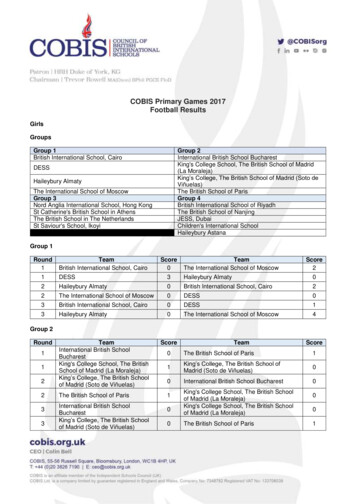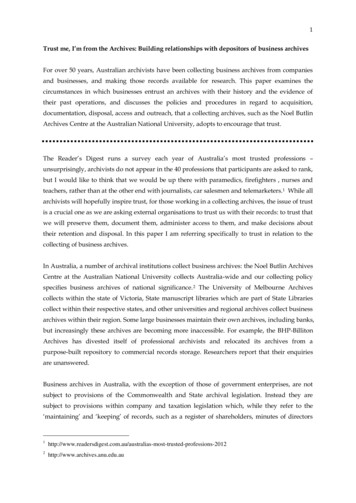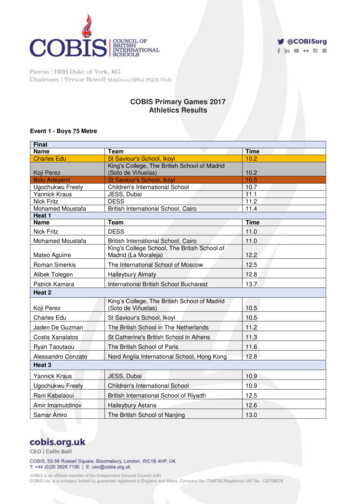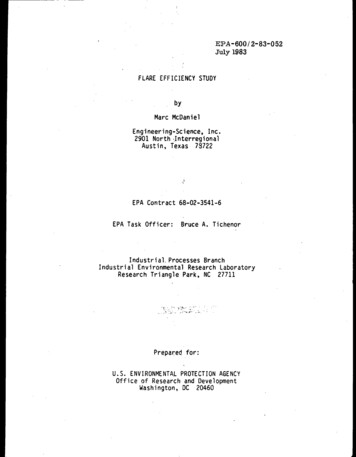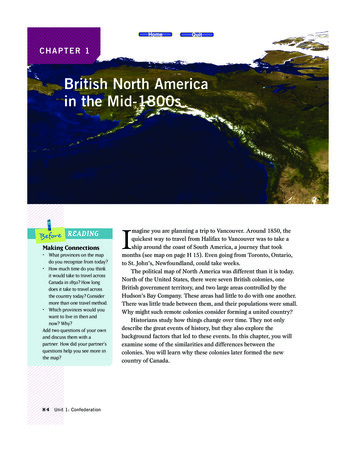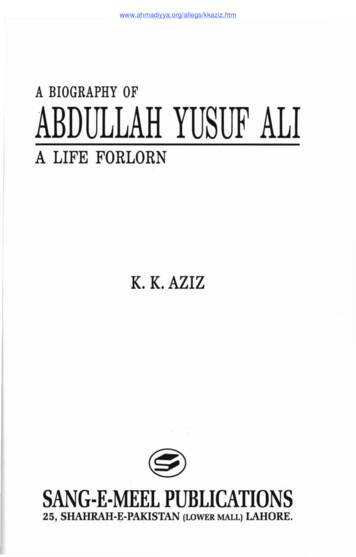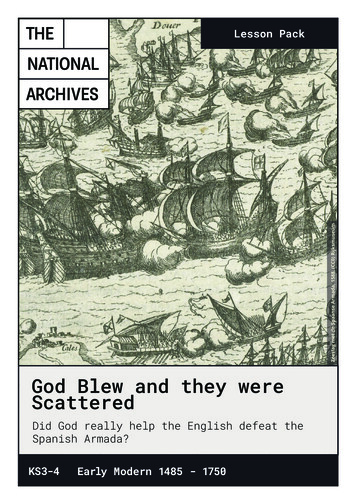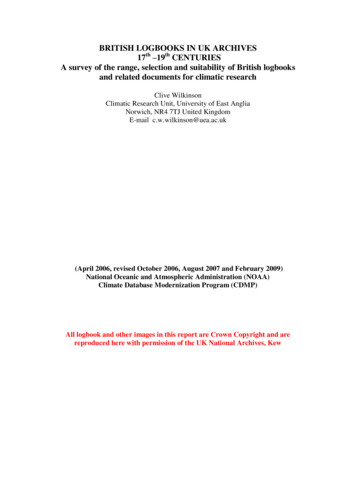
Transcription
BRITISH LOGBOOKS IN UK ARCHIVES17th –19th CENTURIESA survey of the range, selection and suitability of British logbooksand related documents for climatic researchClive WilkinsonClimatic Research Unit, University of East AngliaNorwich, NR4 7TJ United KingdomE-mail c.w.wilkinson@uea.ac.uk(April 2006, revised October 2006, August 2007 and February 2009)National Oceanic and Atmospheric Administration (NOAA)Climate Database Modernization Program (CDMP)All logbook and other images in this report are Crown Copyright and arereproduced here with permission of the UK National Archives, Kew
2ContentsIntroduction.page 41.Scope, range and organization of the collections. page 41.1 The National Archive1.2 British Library1.3 National Maritime Museum1.4 Hydrographic Office2.Early Types of Logbook and their Notation – Pre 1850. page 17Early Royal Navy logbooksEast India Company Logbooks3.Instrumental Data in Early Logbooks and Other Related Marine SourcesPre-1850. page 323.1 Royal Navy3.2 East India Company3.3 Instrumental data from merchant shipping3.4 Instrumental data in printed sources3.5 Chronometer Rating Books4.Related Research Aids. page 384.1 Ship Lists4.2 Sailing Instructions, charts, atlases4.3 Operational histories5.Priority Collections. page 44British LibraryNational ArchivesNational Maritime Museum6.Initial Selection and Acquisition of Logbooks for Imaging.page 466.1 British Library6.2 National Archive6.3 National Maritime Museum7.Further Selection Criteria.page 497.1 Suitability for imaging7.2 Duplication7.3 Data quality8.Integration of CLIWOC Data –Duplication.page 529.Royal Navy Logbooks and Marine Data 1850-1899.page 529.1 Royal Navy logbooks – National Archives (ADM 53)9.2 Additional logbooks – National Maritime Museum9.3 Royal Navy Meteorological Registers – UK Met Office9.4 Royal Navy Remarks Books – UK Hydrographic Office9.5 Locating vessels and logbooks 1850-18999.6 Operational Areas9.7 Summary of data in Royal Navy logbooks 1850-9910.Whaling Logbooks.page 6111.Merchant Shipping Logbooks.page 6111.1 Falmouth Packets11.2 Merchant Shipping Meteorological Registers12.Metadata.page 6312.1 Sources for Metadata12.2 Types of Metadata
313.Items of Unusual or Exceptional Interest.page 6913.1 Pacific Ocean – 19th Century13.2 Stationary Ships13.3 North American Lakes13.4 Transports and Troopships13.5 Indian NavyBibliography.page 74Appendix I Early Logbook Abbreviations and Notation.page 76Appendix II Regional Maps of Sailing Tracks.page 78AcknowledgementsThe author wishes to acknowledge CDMP for providing funding for thisreport. Further acknowledgments for assistance and support are also due to ScottWoodruff, ESRL/NOAA, Dr. Dennis Wheeler, University of Sunderland, Frits Koek,Royal Netherlands Meteorological Institute, Dr. Rob Allan and Catharine Ward,Hadley Centre, Fiona Williamson, University of East Anglia, Dr. Andrew Cook, IndiaOffice, British Library, and Rear-Admiral Roy Clare, Dr. Nigel Rigby, Daphne Knottand Andrew Davis, National Maritime Museum, Greenwich.
4IntroductionThis report discusses the range, availability and suitability of ships‟ logbooksin British archives to yield high resolution, instrumental and non-instrumentalclimatic data. The temporal range of the report is the 17 th through 19th centuries (aseparate report, Wilkinson 2009, discusses UK logbooks extending through the mid20th century). In part, this report builds on the experience and expertise developedduring the course of the CLIWOC Project, funded by the European Union from 2001to 2003. CLIWOC (Climatological Database for the World‟s Oceans: 1750 to 1850 http://www.ucm.es/info/cliwoc; García-Herrera et al. 2005) drew on British, Spanish,Dutch and French logbooks in the pre-instrumental period 1750-1850. As well asbeing a separate climatological database, CLIWOC is also becoming part of ICOADS(http://icoads.noaa.gov). During the course of the CLIWOC Project less than 5% ofBritish logbooks were exploited and none after 1830. This report leverages on theexperience of the UK CLIWOC team to enable ongoing exploitation and processingof climatic data from British logbooks to be handled effectively and efficiently. Theother purpose of this report is to explore the potential of the British archives to yieldadditional data for the post-1850 instrumental period. In addition to the CLIWOCdata, selected UK data from this period (probably exclusively based on holdings ofthe Met Office) were digitized into the UK Marine Data Bank (MDB) decades agoand have been blended into ICOADS (Woodruff et al. 2005). The first part of thereport will discuss the range of logbooks available within each archive.Earlylogbooks will then be discussed in detail, including the general availability of earlyinstrumental data. The selection criteria for early logbooks will then be recommendedas well as integration with the existing CLIWOC data, avoiding unnecessaryduplication of material.The latter part of the report will concentrate on theavailability and nature of Royal Navy logbooks from 1850 to 1899, a discussion ofmerchant shipping and whaling logbooks and sources of metadata on 18 th and 19thcentury vessels.1. Scope, Range and Organization of the CollectionsIn the United Kingdom, ships‟ logbooks can be found in three main repositories.These are the British Library (BL), the National Archives (TNA), formerly known asthe Public Record Office (PRO) and the National Maritime Museum (NMM). Each ofthese holds a distinct group of logbooks. The National Archives hold Royal Navy
5logbooks compiled by individual officers, and general ships‟ logbooks recorded bythe officer of the watch. The officers‟ logbooks consist of captains‟ logs and thelogbooks of the master or navigating officer.The British Library collection isprimarily made up of logbooks produced by officers of the East India Company. TheNational Maritime Museum holds the collection of Royal Navy logbooks written bylieutenants.Much smaller collections can be found in museums, county recordoffices and institutions such as the Scott Polar Research Institute, Cambridge, theRoyal Geographical Society, the UK Hydrographic Office, Taunton and the NationalMeteorological Archive, Devon Record Office, near Exeter. It is the collections in thethree main repositories that form the primary focus of this report.1.1The National Archive (http://www.nationalarchives.gov.uk)The National Archive is located at Kew in southwest London. Best access is by tubefrom central London via the District Line. The National Archives are the chiefrepository of papers and documents generated by the activities of the British statefrom medieval times to the present. The major part of the collection of ships‟logbooks was generated by the activities of the Royal Navy and is in originalmanuscript form. The remaining part of the collection is made up of microfilm copiesof the logbooks of the Hudson‟s Bay Company. The original manuscripts of thesereside in Canada.Temporal and Geographic rangeThe Royal Navy (RN) logbooks held in the National Archive begin in 1669 and runthrough to 1976.Logbooks prepared since 1976 are subject to the thirty-yearexclusion rule, as these remain confidential.There are an estimated 220,000individual logbooks. The geographic range of the logbooks is global. The NorthAtlantic, West Indies and Mediterranean are particularly well represented. The RNwas also active in the South Atlantic and Indian Oceans, including the Bay of Bengaland Arabian Gulf. Coverage of these areas is good though less dense than the NorthAtlantic before the 19th century particularly in times of peace. The Pacific Ocean isthe least well represented. The vessels of the Hudson‟s Bay Company, sailing fromEngland to the Company‟s factories in Canada, cover the higher northern latitudes ofthe Atlantic from 1751 to 1870. Many of these also traded in the Pacific. Thenorthernmost regions are represented in the 19th century by a large number of vesselsengaged in Arctic exploration.
6Organization, binding and conditionThe RN logbooks form a subdivision of the Admiralty records (ADM).TheseAdmiralty documents consist of the administrative and operational records of the RNfrom the 17th century to the recent past. The logbooks are organized into the groupsADM 50 to ADM 55 inclusive. Hudson‟s Bay Company logbooks are in BH 1.There are a small number of additional logbooks to be found in ADM 7/777 to ADM7/780. The organization and cataloguing of groups ADM 50 to ADM 52 makes itdifficult to determine the exact number of individual logbooks available or to give anexact number on a decadal basis. This is because some logbooks overlap betweendecades and some volumes contain a very wide range of dates. The cataloguingconvention of grouping logbooks under the name of the ship brings together thelogbooks of different ships in different periods. Any figures given below are howevera very close approximation and sufficiently accurate to give a reliable guide.ADM 50 (Admirals’ Journals)There are 413 volumes of Admirals‟ journals covering the period 1702-1916providing approximately 1,000 logbooks. Some are purely narrative as flag officerswere not required to record the general navigation and management of the ship. Theadmiral did not command a vessel and the captain‟s or master‟s logbook should bepreferred to an admiral‟s journal in all cases.ADM 51 (Captains’ Logbooks)The series of captains‟ logbooks run from 1669 to 1853. They comprise 4,563volumes or pieces, each containing between 4 and 10 individual logbooks. There areapproximately 25,000 logbooks in total. Table 1 gives an approximate number ofindividual logbooks by decade.DecadeLogbooks tal24738Table 1. ADM 51-Decadal Range (figures slightly inflated due to year range or decadaloverlap in some volumes)
7Each individual logbook had a standard original, marble effect paper cover enclosingthe contents, which are bound into this cover. For storage each logbook has beenindividually enclosed in an additional canvas cover with a part number written on theoutside. (These „part numbers‟ are not registered on the National Archive on-linecatalogue system but can be identified by calling up the volume number and countingthe number of individual logbooks listed). Several parts are gathered together andplaced in chronological order in a box designated with a volume or piece number.Each volume usually contains the logs of one named vessel (not necessarily the samevessel) over a period of years. However it is not unusual for volumes to contain thelogs of more than one named vessel. These other vessels have names beginning withthe same letter as the first. In the example to follow, volume ADM 51/1100 containslogbooks for the vessels Zebra and Zephyr. Some of the logbooks in ADM 51 are in ahardbound, book-style, rather than individually collected in a box.Usually a logbook will contain entries for a twelve-month period but there is noregulation concerning this. An officer began a logbook at the commencement of acommission or appointment, and after twelve months often began a new document.Sometimes the new logbook was bound together with the first giving longer coverage.If an officer changed command, his current logbook ceased and another commencedfor his next command. The first page, inside the cover of each logbook, will state thename of the vessel, the name of the captain, and the range of dates covered. If there isno cover, it is either lost or more likely the logbook is a continuation of a previousdocument. If in doubt, the logbook was always signed on the last written page andthis signature should match a logbook title page to be found somewhere else in theset. The final date in the logbook can also be matched to a title page to be certain ofits place in the series.The example following is typical of the contents of a volume. Remarks are theauthor‟s and based on the information from the on-line catalogue and reference toADM 8, the station lists that provide the disposition of all vessels on a monthly basis.
8Author’s Remarks(12 months) stationed off North America(18 months) The gap between 1778 and 1779 couldindicate a missing logbook that may be found inanother archive. Alternatively the Zebra may havereturned to the UK to be re-commissioned in 1780.Zebra1782-1783(3 months) Probably a change of commandingofficer.Zebra1783-1784(18 months)Zephyr1779-1781(22 months) At least two voyages to West Africa1780-1781.Zephyr1781-1782(9 months) Probably de-commissioned at the endof the warTable 2 Contents of ADM 51/1100Name of ShipZebraZebraDate Range1777-17781780-1782The binding of each logbook is such that it can easily be laid flat or nearly flat forimaging (not for the hardbound sets). The binding is not close so the entire page iseasily visible. The quality of paper and ink is usually excellent, making the text clearand readable. The legibility of the handwriting in captains‟ logbooks tends to be verygood and is usually better than more junior officers. In some cases, a professionalclerk or secretary wrote up the logbook, and these are generally very fine examples.If a captain died during the course of a voyage, the first lieutenant signed off thelogbook and recourse would then be needed to the lieutenants‟ logbooks at theNational Maritime Museum for coverage of the remainder of the voyage.The above points apply to those logbooks that are separate and individually wrapped.However some logbooks in this series will be hard bound in binding that will befound to be in poor condition. Care will be needed to keep imaging equipment freefrom dust and in some instances the nature of the binding will make it difficult to laythe logbook pages flat. This will only apply to a small number of the logbooks.ADM 52 (Masters’ Logbooks)The masters‟ logbooks run from 1672 to 1840. The master was the chief navigatingofficer. On smaller vessels, the commander himself performed this function. Thereare 2,103 volumes and about 15,000 individual logbooks. Table 2 provides anapproximate number by decade.
9DecadeLogbooks DecadeLogbooks1672-16794 1760-17699681680-1689125 1770-177910581690-1699705 1780-178916441700-1709726 1790-179925771710-1719366 1800-180934691720-1729335 1810-181915291730-1739311 1820-18293931740-1749647 1830-18401901750-1759764Total15811Table 3 ADM 52 – Decadal Range (figures slightly inflated due to year range or decadaloverlap in some volumes)The covers, binding, condition and organization are the same as the captains‟logbooks and in most respects master‟s logbooks appear identical to the former.Many masters‟ logbooks however contain sub-daily meteorological information withthe hour of the day appended. These are not regular „hourly‟ observations but notesof a change of wind direction, wind force and weather conditions with the hour inwhich such changes occurred. This is a refinement on captains‟ and lieutenants‟logbooks where there is usually a chronological list of wind directions but noindication of the time of day. The CLIWOC UK research team found the abstractionof data from this type of logbook time consuming, therefore the benefit and usefulnessof such refined data needs to be weighed against the additional time required toprocess it.ADM 53 (Ships’ Logbooks)ADM 53 are ships‟ logbooks as distinct from officers‟ logbooks and were kept by theofficer of the watch. They run from 1799 to 1976 (current public availability). Thereare 180,548 separate logbooks. Unlike the earlier series, the piece numbers representan individual logbook. Any logbooks held by the National Archive for the periodafter 1976 are presently (2006) subject to a 30 year exclusion rule. Approximatenumbers by decade for the 19th century are listed in Table 3.DecadeLogbooks DecadeLogbooks1799-1809277 1850-185939661810-1819617 1860-186929731820-1829396 1870-187918871830-1839638 1880-188923281840-18492302 1890-18992830thTable 4 ADM 53 19 century Decadal Range (figures slightly inflated due todecadal overlap in some volumes)
10It should be noted that the large increase in the number of logbooks towards the endof the 19th century is a reflection of a change in logbook format. Some logbooks fromthis period cover less than one year and sometimes less than six months causinginflation of the figures represented.ADM 54 (Supplementary logbooks)This series is made up of 330 volumes and in all 383 individual logbooks. They runfrom 1808 to 1871. They are mostly captains‟ logs though there are some written byother officers.ADM 55 (Ships on exploration) - MicrofilmThis series, available only on microfilm, is made up of vessels on exploration orundertaking hydrographic surveys. It does not contain all vessels on this type ofmission, as many more of these can be found in ADM 51 and ADM 53. The seriesalso contains several merchant ships, East India Company ships and at least onewhaler. The geographic range is extensive but weighed heavily towards the Arctic,Antarctic, and then the Pacific, Australia and the west coast of North America. Asmall number of logbooks are of vessels situated off west and southern Africa, theCape Verde Islands and one example off the Falkland Islands. There are 164 separatevolumes containing 194 individual logbooks. There is a large amount of duplication.For instance the series contains the logbooks of James Cook and all of the officers ofthe Resolution.There is similar duplication of logbooks for the Investigator(Flinders) and Hecla (Parry). When the duplicates are discounted there are about 100logbooks remaining.Six logbooks are specifically designated as meteorologicaljournals. Four of these have observations made in the Arctic, one the Antarctic andone the Pacific (Resolution).Many of the logbooks in this series will containinstrumental data. However, of those sampled many of the earliest did not haveinstrumental data, the Cook and Flinders logbooks, excepted. Instrumental data ishere defined as temperature and barometric pressure, or at the very least, temperaturealone. In this series, logbooks written after 1820 are the most likely to consistentlyrecord instrumental data. These logbooks should be considered a high priority forprocessing, particularly as they are already available on microfilm. It will be possibleto supplement the instrumental data taken from this series by vessels on hydrographic
11and exploratory missions in ADM 51 and ADM 53. A list of all such vessels is inTizard, (1900).ADM 7 (Additional logbooks)ADM 7 contains 36 logbooks including several unspecified Dutch vessels (ADM7/844). Most of the logbooks are from the late 17 th century; another cluster exists forthe 1780s and many of these cover a period of only a few months. A notableexception is the two logbooks of the Aurora (ADM 7/954-5) covering a return voyageto the Far East 1899-1902, and the Algerine (ADM 7/50) in the eastern Pacific 190810.BH 1 (Hudson’s Bay Company)BH 1 is a microfilm archive of the records of the Hudson‟s Bay Company. Theoriginal logbooks, in manuscript form, have been archived in Canada.(http://www.gov.mb.ca/chc/archives/hbca/) There are 130 volumes of logbooks heldon microfilm with references BH 1/1509 to BH 1/1639 inclusive. In total there are437 logbooks, some of which contain multiple voyages.The logbooks wereoriginally microfilmed in alphabetical order but each microfilm set does not alwayscontain just one vessel or voyage. Some of the microfilms contain only part of avoyage, the remainder of the voyage can then be found on the next microfilm in thesequence. The earliest date is 1751 and the series runs through to 1870.Themicrofilm images of the earlier logbooks (1750s) are of poor quality and difficult toread. Many of the logbooks are for voyages from Gravesend in the Thames estuary,northwards around Orkney then west to Hudson‟s Bay and the factories at Moose,Churchill and York. Vessels departed in May to reach the Bay as the ice broke inspring and returned during the months of August and September. The series alsocontains logbooks for vessels voyaging to the Sandwich Islands (Hawaii) and thePacific coast of Canada.Miscellaneous LogbooksSmall miscellaneous clusters of logbooks can be found in unexpected places at theNational Archive.The three items PRO 56-8 are unidentified logbooks.Thecatalogue gives no indication of date or nationality. The section HCA (High Court ofAdmiralty) has a few dozen logbooks, mostly 18th century with a handful covering the1820s to 1840s. Most of these are Portuguese merchant ships.
121.2British Library (http://www.bl.uk)At the British Library, located in central London, there are 50 miscellaneous logbooksscattered among the Additional Manuscripts collection. The India Office e.html) keep the most significant collection.These are the logbooks and journals kept by officers for the East India Company(EIC). There are 3,822 journals; most of them catalogued under prefix L/MAR/B.An essential guide to this collection is Farrington (1999). This catalogue lists eachvessel alphabetically with details of its voyage and the date of arrival at variousdestinations. At the time of this report (2006) there is no on-line catalogue of EIClogbooks. The EIC ceased as a trading organization after 1834, and this is reflected inthe Farrington catalogue.However there are additional logbooks of East Indiamerchant ships for the post 1834 period held in the India Office Record. Theseadditional logbooks are also catalogued under L/MAR/B.Temporal and Geographic rangeThe collection of EIC logbooks starts in the early 17th century, though there are lessthan 200 covering the years before 1700. Most of the logbooks cover the 18 th andearly 19th centuries up until 1834. Each logbook contains the outward and return legof a voyage, traversing the North and South Atlantic Oceans and the Indian Ocean.Many cover the South China Sea and occasionally parts of the western Pacific. Inmany respects they mirror the tracks of the Dutch East India ships whose logbooks areheld in The Netherlands but additionally include good coverage of the Bay of Bengaland parts of the Arabian Gulf.Organization, binding and conditionThe EIC logbooks are bound chronologically under the name of the ship, each volumecontaining three to four logs. Although in hard binding, each page is usually easy toview. Due to the layout and format of these journals, no information is lost at thebinding margin. They will lie reasonably flat for imaging. The general condition ofthe logbooks is excellent. A small number have runs of pages where the ink has fadedmaking it difficult and in some instances impossible to read. The number of theselogbooks is small and the problem is usually confined to a section of the logbook andnot to the entire volume. A very small number of these logbooks have latitude andlongitude recorded in a non-standard format that renders their usefulness problematic.For instance, one logbook from the 1750s, probably as an experiment, recorded
13longitude by magnetic declination only. It should be stated here that many of the laterEIC logbooks contained instrumental data. These data are usually for temperature(common from the 1790s onwards), but barometric readings started to appear about1800 and became more frequent as the 19th century progressed. The availability ofinstrumental data, the wide geographic coverage (at least three oceans per voyage)and the consistency of the sailing routes used suggest that this series should be givenvery high priority for imaging. The CLIWOC UK team found these logbooks to bethe most useful of the various types that they used.1.3National Maritime Museum (http://www.nmm.ac.uk)The National Maritime Museum is located at Greenwich in southeast London. TheMuseum‟s cataloguing system also contains a section ADM for Admiralty records,and the lieutenants‟ logbooks are classified under this heading. The 5,205 volumes ofthese documents were transferred to the Museum from the Admiralty in 1938. Thevolumes are classified under ADM/L, and in common with the other two archives arearranged according to the name of the ship. It is estimated that there are about 62,500individual lieutenants‟ logbooks. The Museum also keeps over 100 journals writtenby officers of the EIC. There are additional naval and merchant shipping logbooks inboth manuscript form and on microfilm, some whaling logs and a few logbooks ofFrench and Spanish warships. Most of these are in miscellaneous collections or part ofa distinct collection of family or company papers.Temporal and Geographic rangeThe lieutenants‟ logbooks run from the 1680s to about 1807, with a handful extendingthe range to 1809. It was about 1806 that lieutenants were no longer required tosubmit logbooks to the Navy Board to receive their pay. It took some months andeven years for these instructions to circulate to those vessels on distant stations,meaning that the number of logbooks begins to tail off after 1806. The geographiccoverage is identical to that of the RN captains‟ logbooks in the National Archives.Lieutenants’ Logbooks - Organization, binding and conditionAs many ships carried more than one lieutenant there is a frequent duplication oflogbooks in this series. This is advantageous in the sense that some officers keptbetter journals than others or were more fulsome in their recording, making it possibleto select the best from a number of journals covering the same voyage; and alsopossibly allowing cross-validation of the observations between duplicate journals.
14There are several captains‟ logbooks bound up with this series. In some instancesthese are duplicates of those found in the National Archives. However there areinstances where a captain‟s logbook has been bound with this series rather than withits proper collection. More importantly, lieutenants could command naval vesselssuch as small sloops, brigs, cutters and schooners. Therefore the logbook of thecommanding officer of a small ship might be found at Greenwich rather than in theNational Archives. There is no consistency in the way the Admiralty separatedcaptains‟ logbooks from those of lieutenants commanding as these lieutenants‟ logscan be found in either archive.Furthermore, where a lieutenant had assumedcommand of a vessel on the death of a captain, his log may also be found inGreenwich though again there is no rule that determined in which archive it would beheld.Where more than one ship is contained in a volume they are usually vessels whosenames begin with the same letter, although there are some exceptions. The individuallogbooks in each volume are for the most part, arranged chronologically though thereis sometimes a wide range of dates represented. Each volume contains anything fromsix to twenty individual logbooksThe lieutenants‟ logbooks have been bound into large volumes. The majority of theseare in the original Admiralty leather binding, each volume being contained in anadditional canvas or paper wrapper. The volumes containing the ships whose namesbegin with letters A to C have been rebound. These rebound volumes present anumber of difficulties for imaging. First where volumes have been rebound, thebinding is sometimes tight making it difficult in some instances to view the very edgeof the inside part of the page. In these circumstances it will be difficult to make thepage flat for imaging and there may be problems with depth of field over the entirepage. Secondly, those logbooks in their original binding present a different set ofconsiderations. The original binding in many cases is disintegrating causing muchdirt and dust when handled. Imaging equipment may need frequent cleaning to ensurea sharp image. The back of the binding is frequently broken and often the individuallogbooks are loose. This does at least allow the pages to be laid flat for imaging.
15A small number of logbooks are badly decayed and possibly beyond preservation.There is no way of knowing the condition until the wrapper is opened. The majority,despite the state of the binding, have pages in good condition. The ink is good andthey are perfectly readable.Other Collections at the National Maritime MuseumOrganization, binding and conditionThe Museum has nearly 1,500 logbooks outside of the lieutenants‟ collection. Thereis no catalogue convention that brings these together and they can appear anywherewithin the collections either as a distinct series within a „section‟ or as part of a groupof company or family papers. Of these, the LOG series (catalogued under section 6 inthe Museum) is particularly good and worthy of consideration as one of the prioritiesfor imaging. There are 496 individual logs. The binding and condition of these isgenerally excellent. A description of the LOG series follows.LOG/CLOG/C contains 79 logbooks of merchant vessels.Many are masters ormidshipman‟s logs for EIC v
In the United Kingdom, ships‟ logbooks can be found in three main repositories. These are the British Library (BL), the National Archives (TNA), formerly known as the Public Record Office (PRO) and the National Maritime Museum (NMM). Each of these holds a distinct group of logbooks. The National Archives hold Royal Navy

